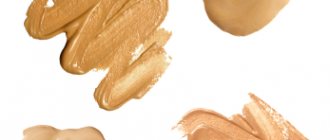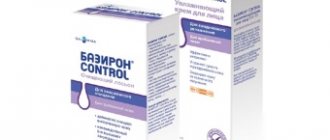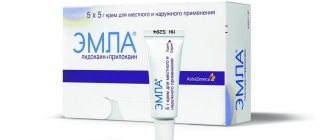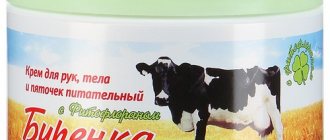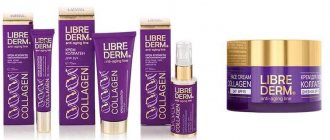Let's figure it out together with Tiinoi Orasmäe-Meder, cosmetologist, president of the Meder aesthetic cosmetology center, medical expert on cosmetic safety at the European Parliament.
How do moisturizers differ from nourishing products? Once upon a time, I would have considered such a question a manifestation of extreme “stupidity.” Of course, nutrition consists of vitamins and fats. Our skin especially lacks them in winter, with its frosts, icy winds and the dwindling supply of nutrients accumulated in the summer. Moisturizers primarily contain humectants. In the spring, when the skin, weakened during the winter, begins to peel off, become irritated, and crack, the main emphasis in care was on moisturizing. But today “everything is mixed up in the Danish kingdom.” Our grandmothers' fatty, dense creams have long been out of favor. Moisturizers contain the same vitamins and fats. And cosmetics manufacturers from time to time joyfully report on the emergence of “universal” creams that can independently “diagnose the problem” and where necessary - moisturize, where necessary - nourish, and at the same time fight excess sebum (oily sheen). Perhaps, indeed, such a division and the recommendations associated with it have lost their relevance?
“In fact, by and large, nothing has changed,” says Tiina Orasmäe-Meder. “In my opinion, there has been an even greater division between moisturizing and nourishing products. First of all, this is due to the emergence of low molecular weight application forms of hyaluronic acid. But here we need to clearly understand what goals we set for ourselves when choosing a means.”
Factors affecting skin condition in winter
The main reason for unpleasant and sometimes painful changes in the skin is dehydration. Sometimes it can be an allergic reaction to the cold, a genetic trait in the skin, or a skin infection. Before solving the problem yourself, cosmetologists recommend contacting specialists. You need to look at the root. The external condition of the epidermis can be corrected, but without knowing exactly the cause of changes in the skin, it is impossible to get rid of the repeated appearance of peeling, cracks, tightness and an unhealthy appearance.
The main factors affecting the condition of the skin in winter: frost and wind, sudden temperature changes, dry air outdoors and indoors.
All this negatively affects the protective lipid layer. Dry air draws moisture from the skin and it becomes sluggish and loses its natural color.
Dry skin suffers greatly in winter. For her, the cold snap is a disaster. Without proper care, it ages, peels and cracks. If you neglect it and do not help it in time, the cracks will become very painful and begin to bleed. Moreover, cracks are an excellent conductor for all kinds of infections and viruses.
Oily skin also suffers from cold weather. It becomes more greasy, changes color, and peeling appears. These are signs of dehydration.
Redness and the appearance of spider veins are possible. This happens because blood vessels constantly expand and contract due to temperature changes.
Benefits of Tinted Moisturizer
Tinted moisturizer is a type of cosmetic product. It combines lightweight hydrating ingredients with a small amount of tinted foundation to create a more even-toned appearance with just one product. A tinted moisturizer can be a great choice for those who don't need heavy coverage, or for those who travel frequently and prefer to take minimal makeup products with them.
Tinted moisturizer is often oil-free and is suitable for those with sensitive, oily or acne-prone skin. For those who require a thicker foundation or a specific customized moisturizer, such as very dry or allergy-prone skin, this type of product may not be the best choice. But for those who have relatively normal skin, this type of cream will help reduce the time of applying makeup.
Tinted moisturizers typically come in a variety of shades, from ivory to darker tones. Since moisturizer and makeup are mixed together in one bottle, they can be applied evenly over the entire face. This will help hydrate your face and also hide any blemishes or small blemishes on your skin. These types of face creams are always made in liquid form, and can even be mixed with other moisturizing products before application for greater effectiveness.
Many tinted moisturizers also contain sunscreen, making them a convenient three-in-one product. For those who travel frequently, this can be very useful because sometimes you only need to pack one product rather than three separate items. Plus, it can really speed up the process of applying makeup in the morning and also ensures that your face is protected from UV rays. If an additional concealer is needed, it should usually be applied to the skin before a tinted moisturizer.
If you choose the right cream, it can add lightness to makeup and create a natural look in which the face looks as if there is no makeup on it. However, for those who have particularly oily skin or a lot of blemishes and pigmentation, an additional application of mineral powder on top of the tinted moisturizer may be necessary. This can make your makeup last longer and maintain a more matte finish, preventing oily skin. Keep in mind that tinted moisturizer should only be worn during the day and not as a nighttime moisturizer, where it can potentially clog pores.
Tips from cosmetologists
It is important to change your mind in time! As it gets colder, the whole body begins to work in “winter” mode. General advice from cosmetologists:
- In winter cold, the cream should not only moisturize and nourish, it should perform a protective function. It should contain: silicone, sorbitol, glycerin, natural oils;
- Mink oil is considered one of the best. This is a natural oil of animal origin that promotes skin restoration. Thanks to mink fat, cracks can be easily removed. This component in the cream is perfectly absorbed;
- Vaseline creates a thick film, which is not always beneficial for the epidermis. Such creams are suitable for very dry skin or for those with dermatitis or psoriasis;
- Another important recommendation from cosmetologists. Use toner after washing your face and before applying cream. In winter, it should be alcohol-free. This is an excellent base for applying cream;
- Before going outside, apply nourishing cream no later than 45 minutes before going out so that it has time to be absorbed;
- For lovers of outdoor activities in winter, it is recommended to use sunscreen;
- It is not recommended to use powder in winter. Better than foundation. A high-quality cream not only masks defects and evens out, it also performs a protective function.
Intensely moisturizing products
Many representatives of the fair sex make the mistake of purchasing intense moisturizers in the fight against dehydration of the dermis. Such creams “lock” existing moisture in the skin.
This property is quite useful, but not in the cold season, since it can provoke microcracks and frostbite, which develop even greater dryness and sensitivity of the dermis.
Alternative
Creams containing emollients are an excellent alternative.
These substances create a protective film, remove scales, soften the skin, and prevent moisture from evaporating.
How to keep your skin healthy in the cold
Harsh winter requires taking yourself seriously. Here are some rules that you need to follow and make them your habit to keep your skin healthy:
- Carefully cleanse the skin with mousse, foam, micellar water, cleansing oil, emulsion (washing with soap is not recommended, as soap contains alkali, which dries out the skin);
- Wash only with warm water (hot water dries out the skin even more);
- Use day and night nourishing cream, do not forget that the body recovers better at night;
- Scrub and peeling can be used no more than once a week (this should be a very gentle and gentle cleansing);
- Change cosmetics from summer to winter (it is better to use a richer nourishing cream, not water-based, do not use alcohol-containing products);
- Pay special attention to the skin on the lips and around the eyes (there are no sebaceous glands there, so these places are the most unprotected, use hygienic lipstick);
- For long walks in the fresh air, apply a special protective cream no later than 45 minutes before going out;
- Drink at least one and a half liters of water per day (elasticity and healthy color directly depend on the amount of fluid consumed);
- A healthy balanced diet (more vegetables and fruits, a minimum of sweets and smoked foods);
- Try to create an optimal microclimate in the apartment (a humidifier will help with this).
Pay more attention to yourself and your skin. Self-confidence and good mood directly depend on the awareness that you look flawless.
How to make winter cream with your own hands: good recipes
Natural cosmetics are becoming increasingly popular. Homemade creams without preservatives, stabilizers and fragrances are almost ideal in terms of environmental friendliness. After spending half an hour, you can prepare an effective emulsion with your own hands. Shelf life: 1-2 months if stored in the refrigerator in a tightly closed container.
With sour cream
- Mix 5 ml of almond oil and 3 drops of lavender essential oil.
- Combine with 5 g of beeswax melted in a water bath. Cool.
- Add 15 g of sour cream, 1 tablet of retinol and tocopherol (crushed). Stir, cool.
Lecithin
- Mix 3 g lecithin, 15 g avocodo oil and 15 g macadamia oil.
- Combine with melted beeswax (5-10 g).
- Cook for 2 minutes over low heat. Cool.
- Beat with a mixer. Cool.
Which cream to choose for the winter
It is difficult to answer this question unequivocally. An individual approach to choosing a cream is important. Only you know which component of the cream the skin does not perceive, to which allergic reactions are possible. In order not to make a mistake when choosing a skin cream, the best solution is to consult a dermatologist or cosmetologist. General recommendations:
- For skin care in winter, oil-based creams are used, which is especially important for dry and sensitive skin;
- It is worth considering that in winter the sun, even in cloudy weather, has no less impact on the skin than in summer. A cream with SPF 15 or more will reduce the negative consequences;
- The cream must contain components that retain moisture, form a protective film, a vitamin complex, and antioxidants;
- At least 45 minutes before going outside, apply cream with ceramides and oil, which creates a protective film;
- In winter, the skin dries out, regardless of type, so for dry and sensitive skin it is recommended to use a thicker cream than in warmer weather, for normal and combination skin - a cream for dry skin, and for oily skin - a cream for normal skin.
More precisely:
- Dry skin needs to be nourished, moisturized, soothed and protected (rich nourishing cream with oils, vitamins A, C, D and fatty acids);
- Normal and combination skin requires protection and hydration (be sure to support your skin with a nourishing cream at night);
- Oily skin needs support for its hydrolipid balance (day and night creams should have a lighter texture and be well moisturized).
Mattifying lotions
Any mattifying cosmetic product is an aggressive type of cosmetic because it contains alcohol, zinc, and talc.
These substances prevent the production of sebum, which causes the skin to dry out and become overly sensitive in cold weather.
Alternative
Cosmetologists recommend using the following products:
- For oily types, it is better to use creams for normal, combination skin.
- Others can use creams for dry, sensitive types.
In addition, you need to carefully monitor the condition of the dermis and adjust cosmetics.
Face masks in winter
One of the most effective ways to protect your facial skin in cold weather is a mask. For greater effectiveness, the mask is applied at least two to three times a week. It will not take much time, and the result will be noticeable even after the first procedure.
Winter masks soften, moisturize, improve blood circulation, restore the epidermis, and nourish. They will relieve the appearance of peeling on the skin, redness, and tightness. A properly selected mask will help your skin recover and glow with health.
Masks for dry skin
Dry skin is extremely susceptible to cold weather. She needs constant support and additional nutrition. Vitamin and herbal masks will restore balance and remove inflammatory processes. Chamomile, plantain, mint, etc. are well suited... For dry and sensitive skin, oil masks are recommended (jojoba oil, wheat germ oil, almond oil, coconut oil, etc....). It is very important to use honey in masks. This component restores damaged skin well.
Masks for normal and combination skin
Normal skin responds well to fruit and fermented milk masks. You can make a mask using banana. A mask made from carrots with cottage cheese and coconut oil perfectly restores complexion and removes inflammation. Oatmeal masks and a component such as honey will help the skin survive the cold.
Masks for oily skin
An excellent folk remedy is a mask that contains protein and lemon juice. A coffee mask will make your face look younger and tighten your skin. Clay-based masks with the addition of liquid vitamins A and E nourish and make the skin more elastic.
Benefits of Aloe Moisturizer
Using aloe cream on your face in winter has many benefits. Aloe has natural healing, anti-inflammatory properties, so it can help heal and reverse skin damage caused by exposure to cold, sun, pollution and other factors. Those with acne, psoriasis and skin rashes can greatly benefit from using aloe cream as part of their regular skin care regimen. Anti-aging cosmetics contain aloe, which, among other things, stimulates cell rejuvenation. The gel found in aloe leaves is a natural moisturizer for the skin.
Due to its healing and anti-inflammatory properties, aloe is often included in cosmetics and medicines. Although there are over 300 types of aloe, the most commonly found in face cream is aloe vera. The plant requires little watering or care to survive, making it easy to grow at home. Many people find that aloe gel is an excellent home remedy that can be applied directly to burns, scrapes, and insect bites to promote easier and faster healing.
Aloe cream is a moisturizing product for oily skin. Even oily skin needs regular moisturizing, and the wrong cream causes pustules to appear, clogs pores and makes the skin oily. However, aloe-based face cream is non-greasy, does not clog pores or irritate the skin. It also absorbs quickly into the skin, allowing the skin to breathe. Many people with oily skin also suffer from acne and should exercise caution when choosing a moisturizer. People who suffer from acne may find that when they start using aloe cream, their acne scars heal faster and breakouts disappear faster.
Although there are many commercial skin care products that contain aloe, you can create a homemade cream. Homemade aloe cream can be made using a few simple ingredients, including aloe gel and skin-nourishing essential oils such as rose oil. The cream is made using beeswax, which must be melted. Then the wax, heated essential oil and aloe gel are added to the blender and mixed for a few minutes. Once completely cooled, the mixture is poured into a sterile container and sealed. And you can use a homemade moisturizer with aloe.
What salon procedures can be done in winter?
Some salon procedures are more in demand in winter.
- Photorejuvenation - the procedure is not carried out in the summer due to the large amount of ultraviolet radiation. Photorejuvenation starts the process of cell regeneration. You can eliminate hyperpigmentation and hide blood vessels with targeted treatment. And when the tissues warm up, the synthesis of elastin and collagen starts;
- Peeling - properly performed peeling in winter conditions will not harm the skin. Skin color improves, small wrinkles and defects disappear;
- Biorevitalization - injections of hyaluronic acid. Relieves curpulosis. The skin is saturated with moisture. Hyaluronic acid does not have a moisturizing effect, but attracts fluid;
- Massage.
conclusions
- Winter creams are multifunctional, this is reflected in their composition. It is necessary to clearly understand how the formula of the chosen product meets the needs of the skin and the conditions of use.
- Winter skin care cosmetics are varied in purpose, skin type and method of action. Each type has its own characteristics, and this must be taken into account when choosing. So for kids there is a separate list of children's winter creams.
- In order for the product to be as effective as possible, you must follow the rules of storage, application, and the compatibility of different sets of care products.
- Winter creams can be prepared at home from simple available ingredients. Provided they are carefully executed and stored correctly, they will help achieve a good effect without high costs.
Age characteristics
How to protect mature skin from frost? To prevent signs of skin aging, it is necessary to carry out special facial skin care It is not recommended to take vitamins or use anti-aging cream during the day, or use a serum with a moisturizing effect at night.
When choosing a cream, pay attention to its composition; it should contain natural ingredients with minimal use of auxiliary additives.
It is easy to purchase such a cream - just choose pharmacy brands of cosmetics.
One of the best options for winter facial care is a cream based on thermal waters .
Common misconceptions about winter face cream
In order not to harm your appearance with radical measures that seem optimal, you need to highlight several common misconceptions about the use of protective cream in winter.
Such erroneous opinions include:
- Skin type changes in winter. Actually this is not true. Skin type cannot change seasonally. It’s just that in winter, any skin begins to experience stress and becomes drier. Therefore, when choosing your cream for winter care, you need to take what is intended for the skin of the neighboring type. This way there will be no sudden change in the active formula.
- The moisturizer immediately crystallizes and injures the skin. This is true, but not everything is so bad. Any cream contains water, the question is in what quantities. Body temperature maintains the cream in a normal state and prevents water crystals from injuring the dermis.
- You only need to use one cream. You can choose several creams if they satisfy your needs fully. You also need to remember about toner, eye cream, cleanser, etc.
Dry or combined
For girls with combination and dry skin, you should give preference to oil-based creams ( containing oils ). This cream will be a helper in the winter and will perfectly protect the skin from chapping and subsequent peeling.
The best option in this case would be a regular baby cream ; it actively nourishes and moisturizes the skin and can be used as a base for makeup.
Products
Cream manufacturers that you should pay attention to:
- Matis . Nutritious cream. It is rightfully considered an ambulance in the winter. Its name speaks for itself SOS Nutrition from Matis. It contains natural extracts of medicinal herbs such as chamomile and verbena, thanks to which the skin is restored after microcracks from frost and inflammation. This is a nourishing oil-based cream that is used at night.
- Avon . Protective day cream for face. One of the more budget options that does an excellent job of protecting. It will prevent chapping, and with regular use it will help eliminate roughness and dryness of the skin.
- Clinique . Moisturizing cream. For milder winter weather, a cream that maintains normal skin condition is suitable. Such a cream is Comfort on Call Tested Relief Cream. It can perfectly soften and soothe sensitive skin. Using this cream will prevent irritation and help restore microcracks after exposure to frost.
- Oriflame . Winter protective cream. The second inexpensive option for protection against winter cold is a cream from the manufacturer Oriflame. Thanks to its good composition, it is able to restore the lipid barrier. The composition of the cream contains vitamin E, as well as natural oils. Therefore, skin regeneration and nutrition are ensured at an affordable price.
Composition of the product - what components should be present and what should be avoided
A face cream in winter must have the correct composition to cope with the task assigned to it. If you give preference to natural creams, you can be sure that its components will not let you down.
After analyzing the label, you need to make sure that the cream contains:
- Shea butter - nourishes the skin, makes it soft and radiant.
- Avocado oil - heals and eliminates defects.
- Vitamin E gives smooth skin.
- Jojoba, cedar or cocoa oil creates a protective lipid film on the skin, which prevents harmful components and cold from penetrating into it.
- Panthenol - promotes the healing of defects and signs of frostbite, moisturizes the skin.
- Vitamins give elasticity and firmness.
- Hyaluronic acid and glycerin - softens and smoothes the skin.
Natural creams may include chamomile, calendula and other herbs and extracts from them. Propolis and other bee products are also often used. Such a specialized cream should consist of 70 - 80% fats and vegetable oils, and it should contain as little water as possible.
Care should be taken to ensure that the product does not contain petroleum products:
- mineral oils;
- petrolatum;
- paraffin.
These harmful components actually retain moisture, preventing it from evaporating. But the caveat is that when using a cream with these components for a long time, the skin becomes unable to independently maintain its water balance. Allergic reactions are also possible if you purchase a dubious product.
For those who are prone to frequent allergies, it is better to first test the cream on a separate area of the skin to ensure its quality.



